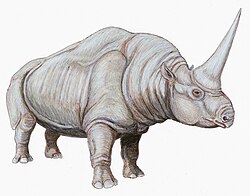Hyrachyus
Hyrachyus (from Hyrax and Ancient Greek: ὗς "pig") is an extinct genus of perissodactyl mammal that lived in Eocene Europe,[1] North America, and Asia. Its remains have also been found in Jamaica.[2] It is closely related to Lophiodon.[3]
| Hyrachyus Temporal range: Eocene
| |
|---|---|

| |
| Fossil | |
| Scientific classification | |
| Kingdom: | Animalia |
| Phylum: | Chordata |
| Class: | Mammalia |
| Order: | Perissodactyla |
| Superfamily: | Rhinocerotoidea |
| Family: | †Hyrachyidae |
| Genus: | †Hyrachyus Leidy, 1871 |
| Species | |
| |
Description
[edit]Spanning 1.5 meters in length, Hyrachyus was related to palaeotheres. Physically, it would have looked very similar to modern tapirs, although it probably lacked the tapir's characteristic proboscis. Its teeth, however, resembled those of a rhinoceros, supporting the idea of its relationship with that group.[1] It is proposed by some that Hyrachyus (or a Hyrachyid of similar form) served as a common ancestor for North American rhinoceratoids.[4]
References
[edit]- ^ a b Savage, RJG & Long, MR (1986). Mammal Evolution: an illustrated guide. New York: Facts on File. p. 191. ISBN 0-8160-1194-X.
- ^ Domning, D. P.; Emry, R. J.; Portell, R. W.; Donovan, S. K.; Schindler, K. S. (December 1997). "Oldest West Indian Land Mammal: Rhinocerotoid Ungulate from the Eocene of Jamaica". Journal of Vertebrate Paleontology. 17 (4). Society of Vertebrate Paleontology: 638–641. Bibcode:1997JVPal..17..638D. doi:10.1080/02724634.1997.10011013. JSTOR 4523853.
- ^ Hayden, F.V. Report of the United States Geological Survey of the Territories, Volume III. (1883)
- ^ Scott, William Berryman (1913). A history of land mammals in the western hemisphere. Smithsonian Libraries. New York, The MacMillan Company.










